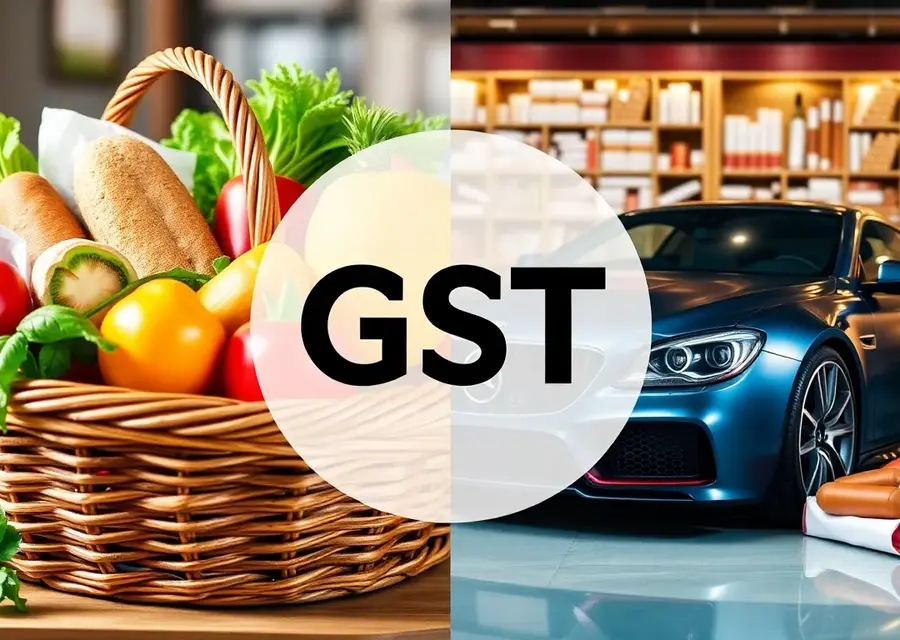GST Rate Changes: What Becomes Cheaper, What Gets Dearer from Sept 22
- THE MAG POST

- Sep 4
- 5 min read

The recent restructuring of Goods and Services Tax (GST) rates, set to take effect on September 22nd, marks a pivotal moment in India's fiscal policy, promising to reshape consumer spending and business strategies alike. This comprehensive overhaul, announced by Finance Minister Nirmala Sitharaman, aims to offer considerable relief to the common citizen by bringing essential items like bread and paneer into the 0% tax bracket, thereby making daily necessities more affordable. Concurrently, the government is escalating the 'sin tax' on demerit goods, such as tobacco and luxury cars, to a significant 40%, a move designed to discourage consumption and boost government revenue. Navigating these changes requires a clear understanding of what will become cheaper and what will be more expensive, impacting everything from household budgets to corporate financial planning.
Understanding the Nuances of GST Rate Adjustments
The Indian government's recent overhaul of Goods and Services Tax (GST) rates, slated for implementation on September 22nd, presents a significant shift in the taxation landscape. This strategic recalibration aims to provide much-needed relief to the common populace by reducing the tax burden on essential commodities, while simultaneously increasing the levy on demerit goods. The move, heralded as a substantial 'Diwali bonus' by some, is poised to impact consumer spending, business operations, and the overall economic trajectory. Understanding the specifics of these changes – what becomes cheaper and what gets pricier – is crucial for both individuals and businesses to navigate this evolving fiscal environment effectively.
Shifting Tax Brackets: From Essentials to Luxuries
The core of the GST reform lies in its reclassification of various goods and services across different tax slabs. A notable aspect is the expansion of the zero-tax bracket, bringing items like bread and paneer under its purview. This decision is expected to directly benefit households by lowering the cost of daily necessities, potentially leading to increased purchasing power and a boost in consumption of these goods. The government's intent here is clear: to ensure that basic sustenance remains affordable and accessible to all segments of society.
Relief for the Common Citizen
The inclusion of several everyday items into the 0% GST category is a significant win for consumers. This means that the final price paid by the end-user for these products will be lower, effectively increasing disposable income. This could spur demand for these goods, benefiting manufacturers and retailers alike. The ripple effect might also be felt in related industries, as increased spending on essentials could free up funds for other discretionary purchases, stimulating broader economic activity.
The 'Sin Tax' Escalation
Conversely, the government has opted to increase the 'sin tax' on items such as tobacco products and luxury automobiles, pushing their GST rates to a substantial 40%. This move serves a dual purpose: to discourage the consumption of goods deemed harmful or non-essential and to augment government revenue from these sectors. The higher tax on luxury items aims to curb ostentatious spending and potentially redirect resources towards more productive economic areas. This could lead to a slowdown in the sales of high-end vehicles and a decrease in tobacco consumption, aligning with public health and fiscal prudence goals.
Impact on Consumer Durables and Electronics
The consumer durables and electronics sector is also bracing for changes. Reports suggest that items like smartphones, tablets, and laptops might see their prices adjusted. While the exact tax implications for these categories are still being clarified, consumers are advised to weigh the benefits of waiting until September 22nd against immediate purchase needs. The potential for price reductions could influence buying decisions, especially for high-value electronic goods, leading to a temporary dip in sales for those who delay their purchases.
Strategic Timing and Economic Implications
The timing of these GST rate changes, particularly with the festive season approaching, is strategic. By making essential goods cheaper, the government aims to boost consumer sentiment and spending during a crucial period for retail. However, the increased tax on certain items might lead to a short-term inflationary pressure in those specific segments. Businesses will need to adapt their pricing strategies and inventory management to align with the new tax structure, ensuring compliance and optimizing their financial operations.
Broader Economic Ramifications
Beyond immediate consumer impacts, these GST adjustments carry broader economic implications. The shift in tax revenue collection between the center and states, with an estimated Rs 48,000 crore potential loss for the center due to GST reforms, warrants careful monitoring. While state revenues might see an uptick, the central government's fiscal position could be affected. This necessitates a careful balancing act to ensure fiscal stability while pursuing economic growth and equitable distribution of wealth. The success of these reforms will ultimately be measured by their contribution to sustainable economic development and improved living standards for all citizens.
Navigating the New Tax Regime
For businesses, adapting to the revised GST rates involves more than just updating price lists. It requires a thorough understanding of the classification of their products, potential impacts on supply chains, and adjustments in sales and marketing strategies. Transparency in communicating price changes to consumers will be paramount in maintaining trust and customer loyalty. Proactive engagement with tax consultants and relevant government advisories will be key to a smooth transition and to leveraging the opportunities presented by the reformed tax structure.
Concluding Thoughts on Fiscal Evolution
The latest GST rate changes represent a significant evolution in India's indirect taxation system. By carefully balancing the need to provide relief on essential goods with the imperative to curb consumption of demerit items and bolster government revenue, the authorities are attempting a delicate fiscal maneuver. The success of this ambitious plan hinges on its effective implementation, the subsequent consumer and business response, and its long-term contribution to India's economic health and prosperity. As the nation heads into the festive season, these tax adjustments will undoubtedly be a focal point of economic discussion and consumer behavior.
Category | Previous GST Rate | New GST Rate | Impact |
Essential Groceries (e.g., Bread, Paneer) | Varied | 0% | Price reduction, increased affordability |
Tobacco Products | Varied | 40% (Sin Tax) | Price increase, discourages consumption |
Luxury Automobiles | Varied | 40% (Sin Tax) | Price increase, aims to curb ostentatious spending |
Consumer Electronics (e.g., Smartphones, Laptops) | Varied | Potential adjustment (details pending) | Consumers advised to check prices post-implementation |
Other Goods and Services | 0%, 5%, 12%, 18% | Revised rates across slabs | Requires careful review by businesses and consumers |
















































Comments